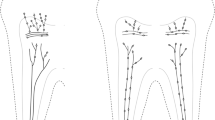Summary
Immunohistochemistry by use of an antiserum against neurofilament protein (NFP) was applied for staining nerve fibers in the predentin and dentin of human third molars. By devising methods for fixation, decalcification and immunostaining, nerve fibers were clearly and specifically demonstrated in thick (more than 50 μm) sections of teeth. Numerous NFP-positive fibers were distributed in the predentin throughout the coronal region, while a few positive fibers penetrated only a short distance into the dentin. The NFP-positive nerve fibers in the predentin took transverse and complicated courses across, rather than penetrating longitudinally through, the dentinal tubules. Pain sensation in the teeth might be attributable to these complex nerve fibers showing two or three-dimensional extensions.
Similar content being viewed by others
References
Arwill T (1967) Studies on the ultrastructure of dental tissues. II. The predentine-pulpal border zone. Odontol Rev 18:191–208
Arwill T, Edwall L, Lilija J, Olgart L, Svensson SE (1973) Ultrastructure of nerves in the dental-pulp border zone after sensory and autonomic nerve transection in the cat. Acta Odontol Scand 31:273–281
Bernick S (1948) Innervation of the human tooth. Anat Rec 101:81–107
Byers MR (1980) The development of sensory innervation in dentin. J Comp Neurol 191:413–427
Byers MR (1984) Dental sensory receptors. Int Rev Neurobiol 25:39–94
Byers MR, Dong WK (1983) Autoradiographic location of sensory nerve endings in dentin of monkey teeth. Anat Rec 205:441–454
Byers MR, Kish SJ (1976) Delineation of somatic nerve endings in rat teeth by radioautography of axon-transported protein. J Dent Res 55:419–425
Byers MR, Matthews B (1981) Autoradiographic demonstration of ipsilateral and contralateral sensory nerve endings in cat dentin, pulp, and periodontium. Anat Rec 201:249–260
Byers MR, Neuhaus SJ, Gehrig JD (1982) Dental sensory receptor structure in human teeth. Pain 13:221–235
Coons AH, Leduc EH, Connolly JM (1955) Studies on antibody production. I. A method for the histochemical demonstration of specific antibody and its application to a study of the hyperimmune rabbit. J Exp Med 102:49–63
Corpron RE, Avery JK, Cox CF (1972) Ultrastructure of intradentinal nerves after resection of the inferior alveolar nerve in mice. J Dent Res 51:673
Dalsgaard C-J, Björklund H, Jonsson C-E, Hermansson A, Dahl D (1984) Distribution of neurofilament-immunoreactive nerve fibers in human skin. Histochemistry 81:111–114
Fearnhead RW (1967) Innervation of dental tissues. In: Miles AEW (ed) Structural and chemical organization of teeth. Academic Press, New York, pp 247–281
Gunji T (1982) Morphological research on the sensitivity of dentin. Arch Histol Jpn 45:45–67
Holland GR (1981) The incidence of dentinal tubules containing more than one process in the cuspal dentin of cat canine teeth. Anat Rec 200:437–442
Itoh K (1976) The distribution of nerves in human deciduous and permanent teeth. Arch Histol Jpn 39:379–399
Iwanaga T, Fujita T, Takahashi Y, Nakajima T (1982) Meissner's and Pacinian corpuscles as studied by immunohistochemistry for S-100 protein, neuron specific enolase and neurofilament protein. Neurosci Lett 31:117–121
Kobayashi S, Itoh K, Gunji T (1981) Tooth pain and pulpal nerve fiber. Dental Outlook 57:1209–1222 (in Japanese)
Maeda T, Iwanaga T, Fujita T, Kobayashi S (1985) Immunohistochemical demonstration of the nerves in human dental pulp with antisera against neurofilament protein and glia-specific S-100 protein. Arch Histol Jpn 48:123–129
Powers MM (1952) The staining of nerve fibers in teeth. J Dent Res 31:383–392
Rapp R, Avery JK, Rector RA (1957) A study of the distribution of nerves in human teeth. J Can Dent Assoc 23:447–453
Seiger A, Dahl D, Ayer-Le Lievre C, Björklund H (1984) Appearance and distribution of neurofilament protein immunoreactivity in iris nerves. J Comp Neurol 223:457–470
Yen SH, Fielder KL (1981) Antibodies to neurofilament, glia filament and fibroblast intermediate filament proteins bind to different cell types of the nervous system. J Cell Biol 88:115–126
Author information
Authors and Affiliations
Rights and permissions
About this article
Cite this article
Maeda, T., Iwanaga, T., Fujita, T. et al. Immunohistochemical demonstration of nerves in the predentin and dentin of human third molars with the use of an antiserum against neurofilament protein (NFP). Cell Tissue Res. 243, 469–475 (1986). https://doi.org/10.1007/BF00218053
Accepted:
Issue Date:
DOI: https://doi.org/10.1007/BF00218053




